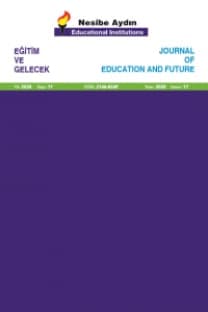Teknoloji Bizim Arkadaşımız: Teknoloji Kullanarak İngilizce Öğrenme Stratejilerini Öğretmek
-
-
Digital teaching and learning, digital resources, technology technology enhanced learning,
___
- AECT (1977). The Definition of Educational Technology, Task Force on Definition and Terminology, Washington, D.C. pp 1,2.
- Barad, D. P.(2009),Pedagogical Issues Related to Speaking and Listening Skills & Sound Editing Software, AudacityLT Weekly, Online Journal, Vol.1(27).
- Barad, D.P.(2010), Experimenting ICT In English Language and Literature, Asia CALL Online Journal. Issue Vol.4 No:1.
- Chapelle, C. A. (2001). Computer-assisted language learning. In R. Kaplan, (Ed.). Handbook of applied linguistics, Oxford: Oxford University Press.
- Dexter, S.L., Anderson, R.E., & Becker, H. J., (1999). Teachers’ views of computers as catalysts for changes in their teaching practice. Journal of Research on Computing in Education, 31(3), 221-239.
- Fraley, L.E., & Vargas E.A. (1975). Academic tradition and instructional technology. The Journal of Higher Education, 46, 1-15.
- Gass, S., (1997). The Handbook of Second Language Acquisition edited by Catherine J. Doughty, Michael H. Long, Douhgty 1998.
- Graddol, D. (1997). The Future of English, The British Council, 1st ed., p 2. Hanson-Smith, E., (2006), http://webpages.csus.edu/~hansonsm/CoP_Resources.html. Community of Practice Resources,
- Januszewski, A., & Molenda, M. (2008). Chapter 1: Definition. In Januszewski, A., & Molenda, M. (Eds.), Educational technology: A definition with commentary. New York: Lawrence Erlbaum Associates.
- Jonassen, D. (2000). Computers as mindtools for schools: engaging critical thinking, 2nd ed. New Jersey: Prentice Hall. Long, M.H., (1981). INPUT, INTERACTION, ACQUISITION, Annals of the New York Academy of Sciences, Volume 379, Native Language and Foreign Language Acquisition pages 259–278, December 1981.
- Long, M.H., (1991). An Introduction to Second Language Acquisition Research, Diane Larsen- Freeman and Micheal H. Long , New York, NY: Longman Inc., p.398.
- Long, M.H., Kanagy,R. & Falodun,J. (1993). Choosing and using communication tasks for second language instruction and research. in G.Crookes & S.M.Gass (Eds.) Tasks and Language Learning: Integrating Theory & Practice. (pp.9-34). Clevedon, UK: Multilingual Matters.
- Owsten, R.D., (1997). the World Wide Web: A Technology to Enhance Teaching and Learning, Research New and Comment March issue, p.27.
- Pica,T., (1994). Research on Negotiation: What Does It Reveal About Second-Language Learning Conditions, Processes, and Outcomes? Language Learning Volume 44, Issue 3, pages 493–527, September 1994.
- Robert J. Blake, Brave new digital classroom technology and foreign language learning, Georgetown University Press, Washington D.C., 2008, p15.
- Roblyer, M. D. (2003). Integrating educational technology into teaching (3rd edition). Upper Saddle River, New Jersey: Merrill Prentice Hall.Roblyer, M.D. (2003), Integrating Educational Technology in to Teaching, Prentice Hall.
- Roschelle J., (2003), Keynote paper: Unlocking the learning value of wireless mobile devices, in: Journal of Computer Assisted Learning, 19:3(260--272).
- Saettler, P. (1990) The Evolution of American Educational Technology: Englewood, CO. Libraries Unlimited.
- Selber, S. (2004), Multiliteracies for Digital Age (Studies inWriting and Rhetoric), USA, p36.
- Smith, M.K., (2002), ‘Howard Gardner and multiple intelligences’, the encyclopedia of informal education, http://www.infed.org/thinkers/gardner.htm, May 2013.
- Warschauer, M., & Kern, R. (2000). Network-based language teaching: Theory and practice. Cambridge, England: Cambridge University Press.
- ISSN: 2146-8249
- Yayın Aralığı: Yılda 2 Sayı
- Başlangıç: 2012
- Yayıncı: Nesibe Aydın Eğitim Kurumları
Uyum ve Hazırlık Çalışmalarının Matematik ve Hayat Bilgisi Kazanımları Açısından İncelenmesi
Emine ÖZDEMİR, Burcu Sezginsoy ŞEKER
Okul Öncesi Eğitimde Belgeleme
Zivka KRNJAJA, Dragana Pavlovic BRENESELOVİC
Teknoloji Bizim Arkadaşımız: Teknoloji Kullanarak İngilizce Öğrenme Stratejilerini Öğretmek
Öğrenmenin Nöro Yapı Taşları; Okul Olgunluğunu Geliştirmek ve Öğrenme Güçlüğünü Aşmak
Bestecilik Eğitimi Bakımından Ulvi Cemal Erkin'in Keman Konçertosunun Formal Analizi
Üniversiteler ve Teknokentlerde Eğitim Alanında ARGE Projesi Yürüten Şirketler Arasındaki Sorunlar
Multimedya Ders Kitapları ve Öğretici Bölümlerin Analiz ve Değerlendirmesi
Anlamsal Wiki: Bilgisayar Mühendisliği Eğitiminde İşbirlikçi Öğrenme Ortamı İçin Bir Araç
Gürcan ÇETİN, Rukiye KARAKIŞ, Aydın ÇETİN
Chopin’in G Bemol Majör İmpromptu’nun (Op. 51) Piyano Eğitimi Açısından Biçimsel ve Armonik Analizi
